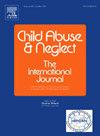Mapping adversities: A network analysis of childhood maltreatment and poly-adversity in a population-based sample
IF 3.4
2区 心理学
Q1 FAMILY STUDIES
引用次数: 0
Abstract
Background
Research on adolescent adversity has consistently shown such experiences rarely occur in isolation. However, not all adversities are equally intertwined, and effective approaches for capturing the complexity of these interconnected experiences have yet to be established.
Objectives
Using a network analytical approach, in this study, we aimed to deepen understanding of the patterns of co-occurrence among various childhood adversities. The analysis included not only intrafamilial maltreatment but also other intrafamilial adversities such as adverse caregiving conditions (e.g., caregiver substance abuse and mental illness), as well as extrafamilial adversities (e.g., peer sexual abuse).
Participants and settings
Data were drawn from a nationwide online survey conducted as part of the UEVO study (Hafstad et al., 2020), involving 9240 adolescents aged 12–16 years from 72 schools across Norway.
Methods
To account for mixed variable types (dichotomous and continuous), a pairwise mixed graphical model (MGM; Epskamp & Fried, 2018) was applied, identifying direct associations between adversities and their relative centrality.
Results
Strong connections were observed among various forms of child maltreatment. Psychological abuse emerged as the most central node, connected to all intrafamilial and extrafamilial adversities. Adverse caregiving conditions also demonstrated high centrality, showing links to both intrafamilial and extrafamilial adversities.
Conclusion
The strong interconnection among adversities, especially the central role of psychological abuse, highlights the complexity of understanding their impact. Shifting from a narrow concept of polyvictimization to a broader poly- adversity framework enables greater recognition of underexplored intrafamilial adversities such as adverse caregiving conditions. This complex web of adversity must be carefully considered in both future research and targeted interventions.
逆境映射:儿童虐待和多重逆境在人口为基础的样本的网络分析
对青少年逆境的研究一直表明,这种经历很少孤立地发生。然而,并非所有的逆境都同样交织在一起,捕捉这些相互关联的经历的复杂性的有效方法尚未建立。目的运用网络分析方法,加深对不同童年逆境共现模式的理解。分析不仅包括家庭内部虐待,还包括其他家庭内部逆境,如不利的照顾条件(例如,照顾者药物滥用和精神疾病),以及家庭外部逆境(例如,同伴性虐待)。参与者和环境数据来自作为UEVO研究的一部分进行的全国在线调查(Hafstad et al., 2020),涉及挪威72所学校的9240名12-16岁的青少年。方法考虑混合变量类型(二分类和连续),建立两两混合图形模型(MGM;Epskamp,应用Fried, 2018),确定逆境与其相对中心性之间的直接联系。结果各种形式的儿童虐待之间存在很强的联系。心理虐待是最中心的节点,与所有家庭内和家庭外的逆境有关。不利的照顾条件也表现出高中心性,显示出与家庭内外逆境的联系。结论逆境之间的紧密联系,尤其是心理虐待的核心作用,凸显了理解其影响的复杂性。从狭隘的多重受害概念转向更广泛的多重逆境框架,可以更好地认识到未被充分探索的家庭内部逆境,如不利的照顾条件。在未来的研究和有针对性的干预中,必须仔细考虑这种复杂的逆境网络。
本文章由计算机程序翻译,如有差异,请以英文原文为准。
求助全文
约1分钟内获得全文
求助全文
来源期刊

Child Abuse & Neglect
Multiple-
CiteScore
7.40
自引率
10.40%
发文量
397
期刊介绍:
Official Publication of the International Society for Prevention of Child Abuse and Neglect. Child Abuse & Neglect The International Journal, provides an international, multidisciplinary forum on all aspects of child abuse and neglect, with special emphasis on prevention and treatment; the scope extends further to all those aspects of life which either favor or hinder child development. While contributions will primarily be from the fields of psychology, psychiatry, social work, medicine, nursing, law enforcement, legislature, education, and anthropology, the Journal encourages the concerned lay individual and child-oriented advocate organizations to contribute.
 求助内容:
求助内容: 应助结果提醒方式:
应助结果提醒方式:


